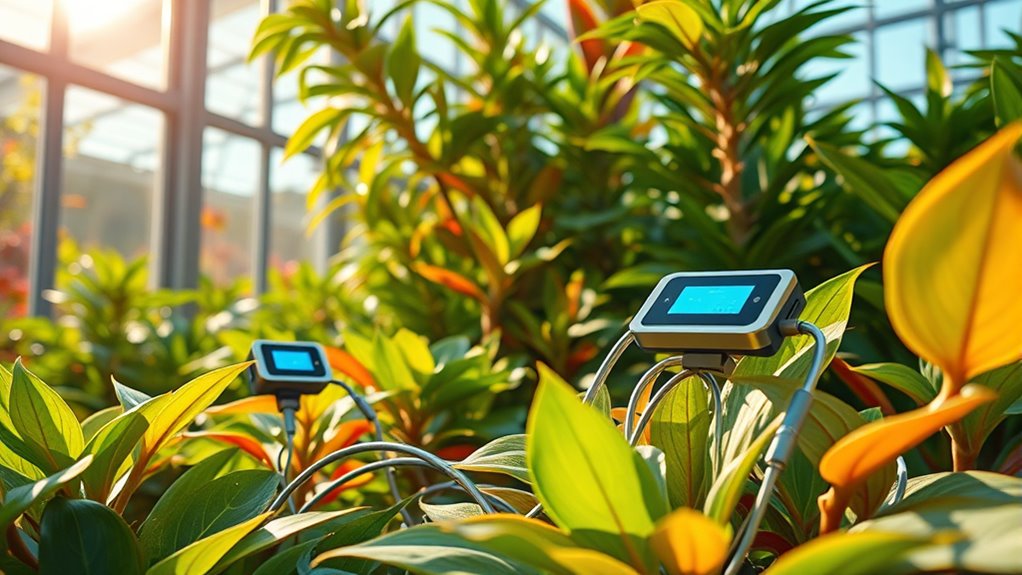To protect your rare plant collection during summer heat, you can use high-tech monitoring systems that include soil moisture sensors, thermal cameras, and infrared sensors. These tools provide real-time data on temperature, humidity, and sunlight exposure, allowing you to react quickly and adjust watering or shading as needed. Predictive analytics further help anticipate heatwaves, ensuring your plants stay healthy. Keep exploring to discover more ways technology can safeguard your plants from extreme heat.
Key Takeaways
- Remote sensors monitor soil moisture, temperature, and sunlight, enabling real-time data-driven management during heatwaves.
- Thermal imaging detects early signs of heat stress, allowing prompt interventions to prevent irreversible damage.
- Data analytics and machine learning predict future heat events, optimizing irrigation and shading strategies proactively.
- Automated watering systems with soil moisture sensors ensure precise hydration, reducing stress during extreme heat.
- High-tech monitoring minimizes physical plant checks, conserving resources and maintaining optimal conditions for rare plant health.

As summer heat intensifies, monitoring rare plants becomes more essential than ever to guarantee their survival. High temperatures can cause significant plant stress, threatening the health and longevity of delicate, endangered species. When you’re managing rare plant collections, understanding how heat impacts these plants is fundamental. Elevated temperatures often lead to dehydration, wilting, and even plant death if not addressed promptly. To combat this, you need effective irrigation strategies that adapt to the changing conditions. Automated watering systems equipped with soil moisture sensors can be game-changers, ensuring each plant receives the right amount of water precisely when it needs it. These sensors provide real-time data, helping you avoid both overwatering and underwatering, which are common issues during extreme heat. Overwatering can drown roots and promote disease, while underwatering accelerates stress and can cause irreversible damage. By integrating these smart irrigation strategies, you can maintain ideal moisture levels, reducing plant stress and supporting their resilience during the hottest months.
High-tech monitoring tools allow you to keep a close eye on plant health without constant physical checks, which can be time-consuming and invasive. For example, remote sensors transmit data on soil humidity, temperature, and even sunlight exposure directly to your device. This immediate insight enables you to react quickly, adjusting watering schedules and providing shade or other protective measures as needed. Thermal cameras and infrared sensors can detect temperature fluctuations at the plant level, revealing early signs of heat stress before visible symptoms appear. This proactive approach is essential for rare plants, which often have limited tolerance to environmental changes. Additionally, understanding how alimony laws impact financial decisions can help you better allocate resources for plant care, especially during unexpected heatwaves. By catching issues early, you can implement targeted interventions, such as misting or shading, to ease plant stress and prevent long-term damage.
Furthermore, integrating data analytics into your monitoring system enhances your ability to predict and prepare for future heat waves. Machine learning algorithms analyze historical and real-time data, helping you develop tailored irrigation strategies that optimize water use while safeguarding plants. This precision minimizes resource waste and ensures your collection remains healthy under extreme conditions. With these high-tech solutions, you become more than a caretaker—you become a proactive guardian, capable of responding swiftly to environmental stresses. Ultimately, leveraging advanced monitoring systems allows you to manage rare plants effectively during summer heat, reducing plant stress, refining irrigation strategies, and ensuring their survival for years to come.
Frequently Asked Questions
What Are the Best Sensors for Detecting Plant Stress?
When it comes to detecting plant stress, you want sensors that monitor soil moisture and light intensity effectively. Soil moisture sensors help you identify drought stress, while light intensity sensors reveal if plants are getting too much or too little sunlight. By using these sensors together, you can quickly spot signs of stress, adjust watering, or shade plants accordingly, ensuring your collection stays healthy and vibrant.
How Does Humidity Affect Rare Plant Monitoring?
You need to understand that humidity levels directly impact your plant’s health by affecting air moisture. When humidity is too low, your plants may suffer from dehydration, while high humidity can promote mold and disease. Monitoring air moisture helps you adjust watering and ventilation strategies. By keeping humidity levels ideal, you ensure your rare plants thrive, especially during extreme weather, and reduce stress caused by fluctuating environmental conditions.
Can Remote Monitoring Prevent Heat Damage Effectively?
Did you know that remote monitoring can reduce heat damage by up to 80%? You can prevent harm by using weather prediction and data integration to track temperature fluctuations in real-time. This technology alerts you early, so you can take action before damage occurs. With remote monitoring, you stay proactive, ensuring your rare plants are protected from extreme heat, even when you’re not physically present.
What Are Cost-Effective Solutions for Small Collections?
You can effectively protect your small collection by opting for affordable upgrades like DIY sensor installation, which makes remote monitoring accessible. Use simple, cost-effective sensors to track temperature and humidity, and set up alerts on your phone. This hands-on approach allows you to respond quickly to heat stress, ensuring your plants stay healthy without overspending. Embracing DIY solutions keeps your monitoring system budget-friendly and tailored to your collection’s needs.
How Do Monitoring Systems Adapt to Sudden Temperature Changes?
Imagine a thermometer’s needle suddenly spiking—your monitoring system reacts the same way. You use thermal imaging to detect quick temperature shifts, giving you instant visual cues. Predictive analytics then analyze patterns, helping you anticipate future changes. This combo guarantees your plants stay safe during sudden heat spikes. By adapting in real-time, you protect your collection effectively, even in unpredictable summer weather.
Conclusion
As you harness high-tech monitoring tools to care for rare plants during scorching summer days, you realize how vital innovation is in conservation. With real-time data at your fingertips, you can respond swiftly to their needs and guarantee their survival. Isn’t it inspiring to think that technology empowers you to protect these delicate wonders? By staying vigilant and embracing new solutions, you’re making a real difference—keeping rare plants thriving for generations to come.










